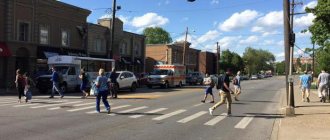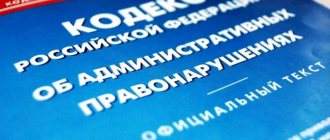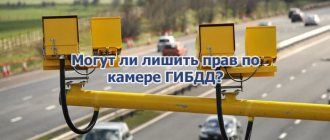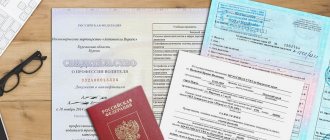Home / Autolight
Back
Published: 03/31/2021
Reading time: 5 min
0
1481
- Is it possible to install strobe lights on a car?
- What are the fines for strobe lighting?
- How to use it correctly so you don’t get fined
- Who can drive with a strobe light
- How to get away with punishment
The penalties for strobe lights of certain colors are significant enough that many drivers believe that installing them is illegal. In fact, there are a number of nuances, knowledge of which will allow you to avoid deprivation of rights and receive the minimum possible penalty or even do without a fine.
What is the penalty?
Special signals can be light or sound . They are supplied using a special device, the installation of which requires permission. You can get it from the traffic police department. After reviewing the documents, the traffic police officer will put the necessary mark on the registration certificate, after which the driver acquires the right to use a special signal. Their use without permission is strictly prohibited and is subject to fines.
For installation on a car
Even if you simply install an unauthorized signal on your car, you will be fined (Article 12.4 of the Administrative Code, Part 2). Individuals who detect violations of this kind will pay 5,000 rubles. Officials are punished with a large amount - for them the fine will be 20,000 rubles. Legal entities will be required to pay 500,000 rubles.
For driving a car
A motorist who dares to drive a car with a signaling device without a permit issued in accordance with the rules risks losing his license for a period of 12-18 months (Article 12.5 of the Administrative Code, Part 4). The devices will be confiscated. Liability also arises if the devices are available but not put into operation. Otherwise, the punishment will be more severe.
When driving
If you turn on a special signal installed in violation of the rules, the deprivation of rights will be for a period of 18 to 24 months. Devices will be confiscated . Responsibility arises in accordance with Article 12.5 of the Administrative Code, Part 5.
For serving while driving
Using devices to signal using light or sound while driving a car, you risk getting a fine if you do not have special permission. If it is not registered with the traffic police, the responsible person may be deprived of the right to drive a vehicle for a period of 1.5-2 years, while devices that violate the rules are subject to confiscation. Responsibility is administrative; for imposing punishment, Article 12.5, Part 5 of the Code of Administrative Offenses is applied.
Reference .
If the fine is paid within 20 days from the date of the decision, its size will be halved. In situations where the execution of a court order is delayed or is carried out in installments, the fine is paid in full.
Responsibility for illegal use of special signals
In the current Code of Administrative Violations, the illegal use of special signals has two articles – 12.4 and 12.5. The first of them contains two points related to the topic under consideration:
- Installation of red or reflective lighting mechanisms. The penalty for such use of flashing lights is a fine. Its amount depends on the status of the offender. An individual will pay 3 thousand rubles, an official – 15-20 thousand rubles, and a legal person – 400-500 thousand rubles.
- Installation of sound and light devices, with the exception of security alarms, without coordination with the traffic police. In this case, liability for the use of special signals is also provided in the form of a fine. Its size is for categories of violators similar to those indicated above: 5, 20 and 500 thousand rubles, respectively.
Article 12.5 establishes punishment for the use of special signals in violation of established requirements in the form of deprivation of the right to drive a vehicle with simultaneous confiscation of an illegally installed flashing light. The term of punishment is determined depending on the nature of the offense and ranges from six months to two years. Illegal use of special signals results in serious sanctions in the form of a fine or even deprivation of the right to drive a car. Considering the dubious benefits provided by a flashing light while driving, it simply does not make sense to violate current legislation.
Concept of sound signal
In regulations, special signals are given the following definition - flashing beacons , can be blue-red or only blue, and can be equipped with a device for transmitting sound. A special signal is a combination of light and sound that foretells the approach of a police car, ambulance, or fire brigade. Equipment equipped with such a signal has a special status. If special conditions are met, all other vehicles are required to give way to them.
The GOST provision, which contains a description of the concept, applies to passenger cars, as well as motorcycles and buses belonging to operational services.
According to the rules, a device for delivering special sound signals is a device capable of producing sounds of a certain spectral composition. It does not apply to the structural elements of the vehicle - the special one differs from the usual sound signal in the spectrum of sounds (clause 11, article 3 of GOST). Installation is carried out according to a permit issued by the traffic police.
Flashing beacons - “flashing lights” are used to provide light signals and must have colors established by GOST , a certain duration of illumination and frequency of blinking (clause 12 of article 3 of GOST). The light device does not belong to the elements that are included in the design of the vehicle. For installation you must obtain a special permit.
Types of "flashing lights"
- Blue (for services 01, 02, 03, 04).
- Red and blue (traffic police, FSB, escort vehicles intended for organized convoys).
- Orange and yellow (evacuation, road special equipment, vehicles carrying cargo of non-standard dimensions, dangerous, with considerable weight).
- White-lunar signal (used for cash collection vehicles, FPS transport).
Orange, white and yellow “flashing lights” are not special signals and do not provide any advantage when driving on roads. Such signals are used only for the convenience of driving on roads. Drivers of special equipment equipped with such devices may not follow some rules when driving.
Is it possible to set FSO flashes to distant in 2021?
So, as we indicated above, there are 2 legal acts that regulate whether such headlights are allowed:
- Basic provisions for permission to operate vehicles (as an appendix to the traffic regulations),
- Technical regulations on the safety of wheeled vehicles.
Let's look at the relevant requirements of both regulations!
Traffic rules requirements
Everything here is simple and quite general. Clause 3.1 of the Basic Provisions prescribes a ban on the operation of a car if the number of lighting devices does not correspond to its design.
And according to the design - how many light sources are installed on your car from the factory, that’s what is provided. That is, it would seem that no additional light sources in the form of FSO flashes are permitted by the Rules.
However, there are also separate requirements for the design of vehicles already in operation on Russian roads. That is, regardless of what the manufacturer of your car has provided. And such requirements are already established by the Technical Regulations in its Appendix No. 8.
What does the Technical Regulations say?
And here everything is a little more confusing and more in content to understand the question of whether it is possible to install FSO flashes on a car as additional lighting. Let's go point by point.
- Requirements for lighting devices are contained in Section 3 of Appendix 8 of the regulations. In paragraph 3.1 we can see that, in particular, the number of headlights must correspond to that indicated in the operating documentation for your car.
- However, paragraph 3.2 of the same section indicates that the installation of additional devices is permitted, but subject to compliance with the requirements of section 1.3 of Appendix No. 4 and section 9 of Appendix No. 9. Well, let's follow them!
- We go to Appendix 4 and see in the table that for category M it is possible to use 2 or 4 high beam headlights. That is, the FSO flash can be installed if the car has 2 standard high-range headlights and no more. “And here is the subtlety of the law establishing the legality of such dopfars!” - you say. But, alas, Appendix No. 4 itself prescribes the possibilities for single vehicles - that is, for those that were produced in one copy. It is unlikely that your car belongs to this category.
- And section 9 of Appendix 9 regulates the rules of compliance when replacing and installing light with the requirements of various regulations (mainly UN Regulations).
Thus, FSO flashes are allowed only for single vehicles and subject to their compliance with certain UN Regulations (availability of type approval, certificates).
However, Appendix No. 8 itself also allows for the possibility of optional light sources. In particular, its Table 3.1 provides for additional 2 high-beam headlights. But we are talking here about category N3 transport, and these are trucks weighing more than 12 tons.
You will also be interested in:
- Is it possible to install eyelashes and DRLs on headlights according to traffic regulations and what is the fine for this?
- What color headlights are allowed and prohibited according to traffic regulations? Can they be tinted?
- Is it possible to drive without headlights day and night and what is the fine?
Terms of use
The installation is considered legal if the owner of the car has bothered to obtain the appropriate permission from the traffic police . Transport belonging to official organizations undergoes the necessary checks in a timely manner to obtain documents. Devices called special signals and used to provide light or sound signals must be certified in accordance with the rules approved by Gosstandart.
The instructions for obtaining permission to use special signals are approved by Order of the Ministry of Internal Affairs No. 194. This fact must be confirmed by a special mark in the vehicle registration certificate. When stopping such vehicles, traffic police representatives will be able to immediately establish the fact of illegal use of equipment.
Reference . A non-certified device cannot be called a “special sound/light signal”. It does not belong to the category of special signals. In controversial situations, lawyers can use this fact as a loophole to build a defense.
Who should?
Sound special signals can be used by drivers of vehicles of government organizations , such as the FSB, police, Prosecutor General's Office, Ministry of Defense, Ambulance, firefighters and other organizations that have the authority to carry out urgent actions to protect the lives of citizens and their health.
Decree of the President of the Russian Federation N 635 in paragraphs. b of paragraph 3 establishes on which vehicles a special signal can be installed, here it is necessary to take into account the amendments to this decree dated 04/06/2019 in connection with the publication of Government Resolution 408.
The changes affected passenger vehicles of professional emergency rescue services and professional emergency rescue units not included in the system of the Ministry of the Russian Federation for Civil Defense, Emergencies and Disaster Relief, devices for supplying special light and sound signals in the presence of special colorographic schemes on the outside the surfaces of these vehicles are not installed.
So, let's look at an excerpt from the Decree and see who is allowed to install a special signal.
The following equipment is equipped with devices for supplying special light and sound signals in the presence of special color schemes on the outer surface of vehicles:
- vehicles of the fire department, police, emergency medical care, professional emergency services, professional emergency rescue units, military automobile inspection, military police of the Armed Forces of the Russian Federation, troops of the National Guard of the Russian Federation, investigative bodies of the Investigative Committee of the Russian Federation, used for the implementation of urgent actions to protect the life and health of citizens;
- special operational and service vehicles of the penal system for transporting persons in custody;
Types of special signals
The subclauses of clause 3 of the traffic rules describe all options for using signals by transport. Let's find out what types of special signals there are and what is their difference.
The first type - blue colors are used, or a combination of blue and red
Ambulances, fire departments, police, and other government special agencies are usually designated.
The light signal is accompanied by a specific sound. In addition, the car must have special color schemes and appropriate inscriptions.
If the established requirements are met - the flashing lights and siren are turned on simultaneously, employees of the institution can take advantage of their advantage. But the main rule must be observed - to ensure traffic safety on the roads.
Traffic priority is granted subject to certain conditions:
- drivers of other cars are obliged to give way to this vehicle, even if the driver of the latter is not driving according to the rules;
- You cannot overtake a car with a special beacon, but the driver of a special vehicle must make sure that they give way before using their priority;
- When the light beacon and sound signal are turned on, vehicles can move ahead or behind an organized convoy to escort other vehicles. Regular vehicles are prohibited from adjacent to or crossing the moving column;
- When approaching a stopped vehicle with a special sign of this type, the driver must reduce the speed to a minimum and, if necessary, make a full stop.
The second type - vehicles use yellow or orange flashing lights
They are used by machines that perform construction or repair work.
Color signals are not accompanied by any sound.
This transport has the right:
Dear reader! Didn't receive an answer to your question? Our expert lawyers work for you. It's absolutely free!
- Moscow ext 152
- St. Petersburg ext 152
- All regions ext 132 (Toll free)
- avoid restrictions set by signs on the roads (with a few exceptions);
- ignore road markings;
- do not adhere to the regulations for the location of vehicles on the roadway.
Drivers of these vehicles may deviate from the approved standards only if they comply with the current road safety rules used by all participants.
An identification beacon of this type does not give priority on the roads; it is used only to warn drivers of possible danger and threat.
Controversial situations of traffic violations
If controversial situations arise, you can seek the services of an experienced lawyer to protect your interests in court. For example, if you are charged with the illegal use of special signals, the defense is sometimes based on the fact that the installed device is not one.
According to the characteristics, special signals include signals that, when turned on, change their tone with a certain frequency. Information about this can be found in GOST R 41.28-99. If the characteristics specified in the technical data sheet of the device do not comply with GOST, the person cannot be accused of using special signals.
Option - a device that does not comply with GOST may be called a dummy . If, for example, there are no structural elements in it, it does not apply to special signals. There is no liability for the installation of dummies.
The driver can also file a complaint against representatives of the traffic police if he believes that the procedure for bringing him to administrative responsibility has been violated. The complaint is submitted to higher authorities; it is better to go directly to the court. The decision will be made based on the circumstances surrounding the specific situation.
Installing a blinking brake light: is it legal?
Have you noticed that on many cars, with the advent of LEDs in the automotive industry, the taillights have become brighter? This is especially true for brake lights. On the one hand, LEDs provide a brighter glow, which contributes to safety on the road. But if we are, of course, talking about standard factory LED lights.
It’s another matter when bright LEDs are installed by fans of popular tuning, without thinking about the surrounding road users, and even less so about the law. Moreover, recently “collective farm tuning” of brake lights in the form of flashing lights has become popular. But is it legal? After all, flickering brake lights (if they are also LED) interfere with other drivers. Let's figure it out.
First, let's delve a little deeper into the essence of the issue. Where did the trend for flashing brake lights come from? The thing is that automakers have been equipping some of their car models with an emergency braking warning system for several years now, which warns drivers behind them about a sharp decrease in speed. This usually happens when the traction control system (ABS) and ESP begin to work at the limits of their capabilities.
Depending on the design of the car and the technologies available in it, the electronics activate a safety preparation mode in case of a collision (seat belts are automatically tightened, windows are closed, braking force is automatically maintained, and a warning mode is activated for drivers of other cars about the risk of an accident).
So, depending on the technology in the car, the hazard lights automatically turn on or the brake lights start flashing.
As you can see, blinking “stops” carry an element of additional security. And we have no doubt that this system has already saved many people and cars from serious consequences. But when blinking tail lights are used for fun, their usefulness turns into a road hazard.
Video from YouTube: youtube.com/watch?v=za6jTzPQFdg
Not only do non-factory blinking brake lights confuse other drivers, but if bright LED lamps are used, they can greatly blind others, which, as you understand, does not lead to increased safety (and even vice versa).
But why then are there more and more cars with similar “popular tuning” on the roads every day? Is this really legal? Let's look at this point point by point.
To begin with, let us recall paragraph 2.3.1 of the Traffic Rules, which describes the driver’s responsibilities:
2.3.
The driver of the vehicle is obliged to: 2.3.1. Before leaving, check and ensure the good technical condition of the vehicle on the way in accordance with the Basic Provisions for the admission of vehicles to operation and the responsibilities of officials to ensure road safetyIt is prohibited to drive if there is a malfunction of the service brake system, steering control, coupling device (as part of a road train), unlit (missing) headlights and tail lights in the dark or in conditions of insufficient visibility, the windshield wiper is not working on the driver's side during rain or snowfall.
(as amended by Decrees of the Government of the Russian Federation dated January 24, 2001 N 67, dated December 14, 2005 N 767)
(see text in the previous edition)
If other faults arise along the way, for which the appendix to the Basic Provisions prohibits the operation of vehicles , the driver must eliminate them, and if this is not possible, then he can proceed to the place of parking or repair, taking the necessary precautions
Now look at paragraph 3.1 in the List of faults and conditions under which, according to the law, operation of the vehicle is prohibited:
3. External lighting devices
3.1. The number, type, color, location and operating mode of external lighting devices do not meet the requirements of the vehicle design.
Note. On discontinued vehicles, it is permitted to install external lighting devices from vehicles of other makes and models.
3.2. Headlight adjustment does not comply with GOST R 51709-2001.
3.3. External lighting devices and reflectors do not work in the prescribed mode or are dirty.
3.4. Light fixtures do not have lenses or use diffusers and lamps that do not match the type of light fixture .
3.5. The installation of flashing beacons, the methods of their fastening and the visibility of the light signal do not meet the established requirements.
3.6. Lighting devices with red lights or red light reflectors are installed at the front of the vehicle, and white ones at the rear, except for reversing lights and registration plate lighting, reflective registration, distinctive and identification signs.
Accordingly, according to the above, non-factory flashing brake lights are prohibited, since their operating mode does not correspond to the factory settings.
It would also be useful to remember the following provisions of the current legislation:
How can the traffic police prove guilt?
A vehicle, when stopped by traffic police officers, can be checked for violations. Representatives of regulatory authorities can check whether they are installed in violation of accepted rules. The fact of illegal use of the device is very easy to establish - you just need to check the documents for the car.
Copies of documents confirming the violation can be attached to the protocol left at the place where the vehicle was detained - a vehicle registration certificate that does not have a mark authorizing special signals. At the discretion of traffic police officers, photos, videos, and witness statements may be attached.
Useful video
The video below explains what fines are imposed for installing and using a special signal without permission.
The safety of all road users depends on the correct operation of headlights and signal lights. Read articles from our experts about what the fine is for violating the use of lighting devices such as: xenon, the presence of diode bulbs in the headlights, not turning on the turn signal and driving in the wrong direction, for tinting the rear lights or front optics, non-working low or high beams or driving in daytime with no lights on.








